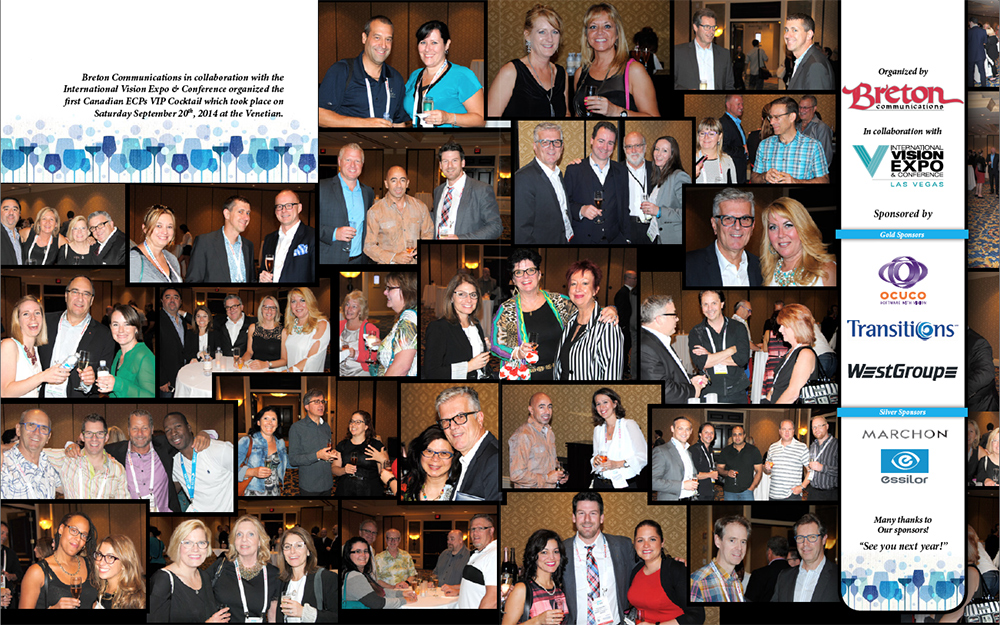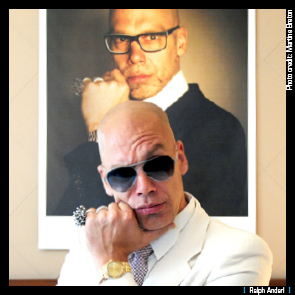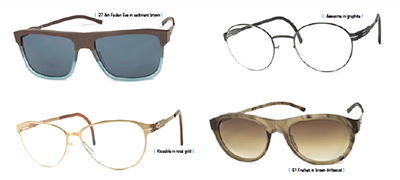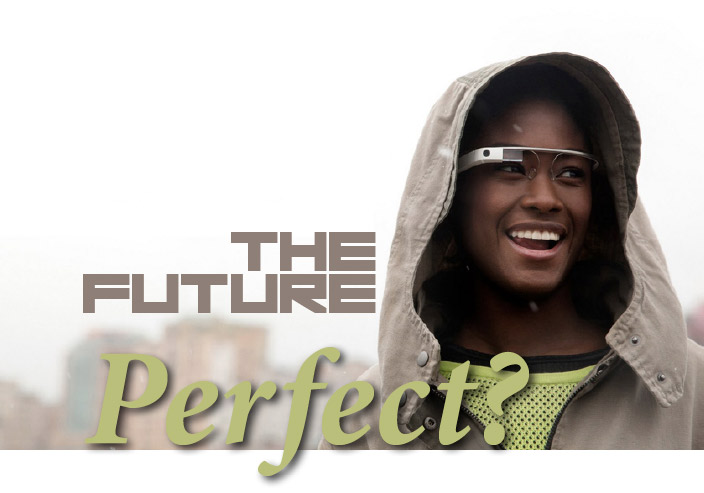Archives de l’auteur : Envision Magazine
Colour it up and More!
Coloured contact lenses are back in the limelight. Even Oprah is wearing them on the cover of the October 2014 issue of O, The Oprah Magazine. You can’t help but be drawn to the dramatic transformation effected by her Pure Hazel lenses, one of nine shades available from the newly launched line of AIR OPTIX® COLORS contact lenses from Alcon. The patented 3-in-1 Colour Technology and silicone hydrogel material have come a long way from the unnatural-looking, dot matrix-patterned, non-disposable lenses introduced in the mid-1980s by Wesley-Jessen. Hopefully, the renewed interest in coloured contact lenses will remind eyecare practitioners that there are other applications for these medical devices – as fashion and beauty products.
Prosthesis
Prosthetic contact lenses can be life changing for patients with permanent disfigurements from congenital birth defects such as aniridia and iris coloboma, diseases such as corneal dystrophies and herpetic keratoconjunctivitis, and trauma/surgery, including lacerations, chemical burns and iridectomy.
Generally, they are used cosmetically to camouflage ocular anomalies and to make the diseased or damaged eye(s) look natural to the observer. In such cases, they help to reduce social distress and boost self-confidence.
Prosthetic contact lenses can be transparently tinted, opaque or hand-painted. They can range from something as simple as a clear lens with a black pupil to an off-axis pupil for disguising a strabismus, to an array of iris imprints, colours, pupil sizes, designs and styles. If the eye is blind, a black pupil may be used; otherwise, the pupil diameter that will provide good visual field in normal-to-bright light conditions should be selected. Sometimes, the whole lens diameter may be tinted to limit or eliminate the amount of light entering the eye, especially in patients with migraines, amblyopia, diplopia and extreme photophobia.
They are fitted for corneal coverage, centration and movement, as with any other soft or scleral contact lens, and they can be fitted with or without a prescription. In monocular cases, a digital photo can be sent to the lab for matching to the colour and iris details of the non-compromised eye.
Sports Vision
Like tinted sports goggles, custom-tinted contact lenses can help to maximize contrast, reduce glare and improve depth perception, but without the decreased field of view caused by the frame apparatus, especially for athletes who want to enhance their sports experience and/or gain a competitive advantage. As a general guide, green-grey tints increase the definition/contrast of contour cues, such as the fairway in golf, the yellow ball against the blue sky in tennis, subtle terrain details in skiing, and a brown critter against green foliage in biking/hunting. In skeet shooting, yellow or brown with red-orange tints can increase both the contrast and depth perception of the reddish-orange clay against its background, and help track, brighten and sharpen the details of low-contrast objects, such as a baseball or a soccer ball in overcast, foggy, low-light conditions.
Colour Vision Deficiencies
Colour vision deficiencies affect about 8 per cent of men and 0.4 per cent of women. Most are hereditary, while a few are caused by ocular diseases such as ARMD and glaucoma. There is no known cure for the inherited form of the condition. Art Optical has a FDA-cleared lens called the X-Chrom® lens. When worn monocularly and over the non-dominant eye, this reddish-tinted therapeutic lens can increase the perception of the red and green wavelengths of light entering the eye such that a person with dichotomous Protan and/or Deutan deficiencies can better detect or differentiate the previously ambiguous figure from the ground in pseudoisochromatic plates tests. The dominant eye without the therapeutic lens continues to have « normal » vision because the blue and yellow wavelengths are not affected.
Other Applications
Some low vision patients with significant glare/photophobic symptoms and reduced acuities from ocular diseases such as albinism, peripheral cone dystrophy and macular degeneration have benefited from red-, yellow- and green-tinted contact lenses. Blue tints have been helpful in reducing light-sensitivity symptoms in traumatic brain-injured patients and also in increasing reading speed in poor readers. Other applications include decorative/novelty or special effects contact lenses for Halloween and other special events and for the TV/movie industry.
Coloured contact lenses can be utilized in various ways, depending on the patient’s needs. Whether their intended use is as fashion accessories, for vision enhancement for recreational purposes, or as treatment for an ocular condition, they remain medical devices and require ongoing contact lens follow-ups to ensure effective lens performance and optimum corneal health.
___________________________________________________________________________________
CASSEL, M. “Changing Lives with Prosthetic Soft Lenses”, Contact Lens Spectrum, April 2010
Ciba Vision ECP Letter: “Product Discontinuation Information”, June, 2011, p. 5
BIRCH, J. “Worldwide prevalence of red-green color deficiency”, Journal of the Optical Society of America. A, Optics, image science, and vision, vol. 29, no 3, March 2012, p. 313-20
ZELTZER, H. The X-Chrom Manual, Second Edition, Massachusettes, 1982, 20 p.
The Yin/Yang Balance at ic! berlin
Ralph Anderl Designs with Big Picture Thinking
Ralph Anderl is ready to die. And yet, he is far from somber. In fact, his is one of the freshest, most original minds in business today.
Anderl, owner of ic! berlin, is a visionary fueled by eastern philosophies, his approach epitomized by Taoism’s yin-yang symbol with its rising and falling forces, interlocked and contained within a circle. An artist and intellectual, Anderl himself embodies the fire of creativity, while also believing that the ‘drier’ aspects of business – accounting, managing, distribution – are part of a harmonious whole.
Let’s be clear: Anderl is not unwell. His ‘ready to die’ statement refers to ‘the art of learning how to die’ and this, he says, is what motivates him to continue in business. “At the beginning of the business the founder acts, creates, develops, but he doesn’t necessarily know why. Over time the process goes to another level and the company, as an entity, needs to know why it is doing what it is doing. I will die within the next 30-40 years, and that fact is integral to everything I do.”
Can a company be a work of art? Anderl sees his company as a form of installation art. The business of creating and selling frames is the fuel that keeps the organism alive. “Our company should be like a whole art piece, even the bookkeeping and logistics. At the end of the day, if all tasks are collaborative and well organized, everything becomes part of a beautiful whole.”
Balancing different interests can lead to battles. Anderl heads a team of five designers and he says, “sometimes the designers get pissed off,” when their vision is in conflict with the people whose job is to manufacture and distribute the frames. “There’s no good and bad,” he says. “It is a pleasure to create and make beautiful things, but in the end the company survives when it makes glasses that people buy. And customers need to receive the product in time, wrapped in a nice parcel, with the invoice.”
Handcrafting frames that last is a strong imperative for Anderl. To that end, he has established a manufacturing facility in the heart of Berlin where the frames are made, sometimes before the curious eyes of tourists who are invited into the factory to view production. “We spent so much money setting up the factory that we didn’t have much left for marketing. We thought that some of Berlin’s many tourists might like to see how eyeglass frames are made in an artisanal way, and so we give them tours. They take their knowledge of our company and our product back home and may become ambassadors for us.”
This handcrafting approach is in direct contrast to frames that are made for fashion purposes only, according to Anderl. “In the fashion industry, products are produced as cheaply as possible and purchased by the consumer with the intention that they will last for only one or two seasons. We work differently. When we design we think about how a colour or design innovation will stand the test of time.”
ic! berlin frames are a perfect balance of the traditional and the new. Their newest metal collection for women, Something I Want to Tell You, is perfectly embodied in the words used to describe some of the models: Elegant, Innocent, Mystical, Playful, Kissable, Awesome and Divine. Subtle, modern materials marry classic shapes from the 1950s and ‘60s: pantos, browlines and cat eyes. This collection was featured at this year’s Vision Expo West. The Katalog 2014, available for viewing through the company’s website (www.ic-berlin.de), reveals strong shapes and either vibrant or subtle colours designed to suit every mood and face.
Interestingly, the models wearing the frames are not nameless, and a few words about each person (some of whom are employees) gives the impression of a company that cares about the individual. And Anderl does care very much about others: “I want to work with people who want to learn and challenge themselves. If they don’t, they won’t be a good part of the art.”
The work of art that is ic! berlin is infused with a playful air. A singer, Anderl started a company choir that meets every Monday morning. The ic! berlin website has a ‘news’ tab that is decidedly ‘un-newsy’, featuring a photo strip contest, videos of Anderl’s trip to Brazil to see the 2014 World Cup of Soccer, and a list of favourite things to do and see in Berlin. One can immediately discern that this is a unique company, informed by a distinct philosophy. It is also one that Anderl wants to last beyond his lifetime.
“If the company is real and independent, then the founder can die. And if we are not considering the possibility of death then we are not creating a relevant work of art.”
The Future Perfect?
By Brian P. Dunleavy
The end of the year is always a good time to make plans, set goals and think about the future.
In this installment of Lens Focus, we’re going to look at where new technology is taking the science of spectacle lens design. If you thought freeform technology revolutionized how your clients see, just check out how these new innovations have taken lenses to the next level.
Watch out, Google. By now, everyone has heard about Google Glass – as well as the product’s promises and pitfalls. Now Sony is entering the rapidly burgeoning “smartglass” market with its new Smart EyeGlass. In essence, the specs act as a secondary screen for an Android-based smartphone, displaying information in the lenses of the wearer, using a tiny projector and hologram system. According to the company, the glasses have a camera mounted in the left-hand lens and use an accelerometer, gyroscope and compass to track the wearer’s movements, overlaying information to create augmented reality. They connect to a smartphone via Bluetooth and Wi-Fi, allowing Android apps to operate through the glasses. Sony plans to launch developer kit versions of the Smart EyeGlass within a year.
Space, the final frontier. Speaking of augmented reality in eyeglasses, Space Glasses also claim to improve on the technology of “smart” eyewear with, its manufacturers claim, 15 times the viewing area of Google Glass. Space Glasses also include audio speakers that add virtual sounds to the user experience, as well as microphones that capture and interpret the user’s spoken commands, using speech recognition technology to respond to requests for desired information and actions. Inventor Dr. Steve Mann has been developing augmented reality systems since the 1980s, through his work at the University of Toronto. In essence, his eyeglass-based technology takes real-world human sensory inputs and enhances them with digital data obtained from the Internet. Dr. Mann is now working as the chief scientist and product developer with Meta Company, which is marketing Space Glasses.
Like the products from Sony and Google, Space Glasses can support prescription lenses, and all three companies plan to work with eyecare providers (optometrists and opticians) in the delivery of their prescription versions.
Then again, who needs glasses? An important market segment for ECPs – computer users – may no longer need eye care services or the premium lens products designed to meet their unique vision needs. Brian Barsky, OD, a professor of computer science and vision science (and affiliate professor of optometry) at the University of California-Berkeley, and researchers from the Massachusetts Institute of Technology (MIT) have developed computer hardware and software improvements designed to achieve increased image resolution and contrast. In one of their projects, they modified an iPod touchscreen by adding a standard light field display consisting of a film with tiny pinholes sandwiched between thin layers of plastic. The team also developed computer algorithms to adjust the light intensity from each pinhole. With this technology, they can use a person’s eyeglass prescription to compute an altered image customized for that individual. Their findings were published recently in the journal ACM Transactions on Graphics.
Lens, heal thyself. Historically, eyeglass wearers – particularly those with lenses made from certain materials and/or treated with certain coatings – experienced issues with durability. Although newer lens products are less problematic in this regard, there is room for improvement. Enter Essilor. They have filed an application with the U.S. patent office for a lens treatment that effectively self-repairs when scratched. Essilor would not comment on the patent application – except to confirm its existence – as the product is still in development.
The products mentioned above may not come up in your client consultations next month or even next year. But they’re definitely worth keeping an eye on for the future.
Opening Your Retail Store: Who? Where? How?
By Paddy Kamen
Whether you’re opening your first store or your umpteenth, there’s plenty to consider, starting with WHO will you be serving, WHERE is best to locate, and HOW will your store speak to your clientele.
The real estate mantra, ‘location, location, location’ is an important one, but like many over-simplifications it belies the complexity of the decisions required to open an optical store. It also ignores the fact that location is not even the first step in the decision-making process. Your store can still fail if location is your only concern.
What comes before location? Who you want to serve, according to the experts. Your ideal customer should be reflected in each essential aspect of your store: location, design and product composition.
“Retailers need to be really clear on who their target market is,” says Margaret Osborne, acting chair of the School of Marketing and Advertising at Toronto’s Seneca College. “People without a marketing background don’t realize how important it is to have an in-depth understanding of their ideal customer. A good marketer will write a story about these customers that might be 30 pages long, looking at their values, attitudes and beliefs in addition to their income and education level. Do they want convenience or intimate service? Are they fascinated by precision goods or do they prefer value above all?”
Customer analysis will contribute to the location decision. “If you understand your customer you will know which location will make or break your business,” says Osborne. “If you’re dealing with clients who value convenience then you should be in a high-traffic location with good parking. If pricing is paramount then you’ll need a location with lower rent. The image has to be consistent as well. If you’re looking to do a boutique offering with higher-quality product, your location will have to be consistent with that as well.”
Intrinsic to Osborne’s argument is that you can’t appeal to everyone and the more you try, the more watered down your value proposition becomes. “If you don’t have a formal background in marketing either seek professional advice or educate yourself online,” she says.
Mani Vaghedi, president of Washington, D.C.-based CNS Frame Displays, agrees with Osborne. Vaghedi advises clients informally on setting up their retail stores and clinics. “The business plan is often the problem. I find that many people don’t narrow down their target market, nor do they plan financially for the six to eight months it takes to get a business on its feet. If they spend too much money in the set up they don’t have enough of a cushion. If they spend too little, their store just doesn’t cut it. An optimized business plan developed with the aid of professionals and a marketing plan for the first few years will go a long way to ensuring success. In my experience the biggest mistake retailers make is under-spending for the practice and not doing enough advertising.”
The type of retailers around your location sets the tone and attracts shoppers. Sometimes it pays to be near those who are your competitors, says Osborne. “You know how you often see gas stations grouped together? Economic game theory says you should locate where you competitors are because that’s where people go to look for eyewear. It’s better to be next door rather than a mile away if your competitors already have traffic, and the smart people go where the action is.”
Anchor stores in the area will be key if your preferred customer is seeking convenience above all. If they can grab a ‘Tim’s’ coffee, pick up their garden supplies at Canadian Tire and drop into a Shopper’s Drug Mart to pick up cosmetics before heading to your shop to choose eyeglass frames or contact lens supplies, they’ll be happy campers, indeed. However, the fashion-oriented customer will be attracted to the eyewear store that is near other fashion retailers.
Michael Kehoe owns and operates Fairfield Commercial Real Estate Inc., a Calgary-based brokerage. He works with commercial property owners and retailers seeking locations across western Canada. “Eyewear is very fashionable so a venue with pro-fashion tenants and jewelers clustered together encourages cross-shopping,” he says. “That way, retailers can enjoy the synergy of the traffic generated by their neighbours.”
Being in ‘the shadow’ of a regional shopping centre that is dominated by chain stores can certainly help, adds Kehoe. “If you can be within four-to-five blocks of a shopping centre on a main road with good signage, you will have achieved more affordable rent than you would in the mall, along with high visibility and consumer traffic.”
Things are changing in retail, with large enclosed malls losing some of their shine for the first time since their inception in the mid-1950s.“Shopping centers are moving toward dining and entertainment centres and offering more services in addition to retail,” says Kehoe. “Some of the older models are being focused outwards (de-malled) and turned into convenience and power centres. The Don Mills Centre in Toronto is an example of this, as is Deer Valley in Calgary, which was de-malled three years ago. This elminates the closed pedestrian mall and focuses the stores outward. The operating costs are lower for the property owners and retailers get more exposure to street traffic. This particularly suits those smaller malls in areas where large regional malls dominate. De-malling is a very successful strategy.”
Strip malls can be an excellent location choice for optical retailers, especially with the synergy of complementary tenants. But optometrist Diana Monea, proprietor of three stores (one in Regina and two in Calgary) once found herself in a problematic situation with one of her strip mall locations. “We had professional, health-related neighbours when we moved in, but then one of them left and was replaced by a business that made patient parking impossible for us. This was extremely frustrating and involved long, arduous and expensive negotiations to resolve.”
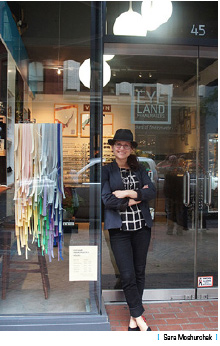 Another location type is the main street store, where pedestrian traffic dominates. Sara Moshurchak moved her store, Eyeland, from the tourist mecca of Granville Island to the Gastown neighbourhood of Vancouver last January. She found that after 20 years on Granville Island that there were fewer locals shopping, her client base was stalled, and tourists were becoming more reluctant to make high-end purchases. Gastown is also a draw for tourists, with charming historic buildings on Water Street, but it also has residential buildings and other fashion retailers (hat makers, shoemakers and clothing designers) who have made the area one of Vancouver’s most attractive to those seeking artisanal goods, such as the handmade frames Moshurchak offers.
Another location type is the main street store, where pedestrian traffic dominates. Sara Moshurchak moved her store, Eyeland, from the tourist mecca of Granville Island to the Gastown neighbourhood of Vancouver last January. She found that after 20 years on Granville Island that there were fewer locals shopping, her client base was stalled, and tourists were becoming more reluctant to make high-end purchases. Gastown is also a draw for tourists, with charming historic buildings on Water Street, but it also has residential buildings and other fashion retailers (hat makers, shoemakers and clothing designers) who have made the area one of Vancouver’s most attractive to those seeking artisanal goods, such as the handmade frames Moshurchak offers.
Moshurchak allows that it was difficult to reach the decision to move, even though she hadn’t been happy in her old location for a while. “Moving location is like starting a new business, and that is scary. But the last year in my old location really pushed me out, with roofing problems that caused business to dip.”
She’s glad she took the leap, despite having sales drop considerably for the first three months in Gastown. “Business is more consistent here, whereas we would alternate between being deluged or dead at the other location. I can now operate with fewer staff, I’m paying less rent and I have a much larger location.”
Working with experienced commercial real estate agents Corbel Commercial was essential to Moshurchak finding the ideal store. “I had never thought of working with agents but two of my friends had used them and they were amazing. They knew the store was going to be available because they were acting for the current tenant who was moving out. They helped me to sort through, understand and negotiate the terms of the lease.”
Marc Saul, vice president of Corbel, says that Gastown commercial property owners are for the most part on the same page when it comes to choosing tenants. “They are distinctive in that they prefer unique, independent retailers you can’t find elsewhere in the city over large national chains and brands. Their goal is to preserve the character of the neighbourhood and avoid retail homogenization. It makes for a more sustainable retail environment in the long run.”
Getting professional help with lease negotiations is critical for retailers. “It’s not every day that a retailer signs a lease but we do it on a daily basis so we understand what landlords will do for the right tenant,” says Saul.
What could go wrong? You may not recognize a clause in the lease that allows the landlord to terminate the agreement if she wants to demolish the building. Or there may be a clause permitting the landlord to renew the lease at her discretion rather than after a fixed term. There may be deficiencies in the building that you wouldn’t recognize due to lack of experience, or you may be required to pay unreasonable rent.
Mani Vaghedi also advises clients to work with an agent. “A bad lease can put you out of business at any time. On the other hand, the landlord is often willing to co-invest with you or even pay 100 per cent of the lease-hold improvements to the right person.”
A good agent might also be able to help you avoid the kind of problems that Monea experienced when the car rental company opened in her strip mall. A covenant on your lease can cover what other stores would be allowed to move in next door. You might get favourable signage placement, new flooring or entrances, or a fresh coat of paint.
IRIS The Visual Group has leased 163 locations across Canada so executive vice president Dr. Daryan Angle knows this aspect of the business very well indeed. “It does help to be a national chain. If landlords don’t know you and feel confident that you will prosper they may not be keen to lease to you. You have to vie for their attention and then negotiate. It’s a delicate dance. But if they know your look and client base they will come to you because they know you will attract other quality tenants.” He advises smaller stores to locate in retail plazas that attract other shoppers and to review the proposed lease very carefully. “After 163 lease negotiations we’ve learned so much about this aspect of the business. Landlords hold a lot of power.”
Space Planning and Design
Once you have the location and the lease in place you are ready to create the right environment for your target client. You would be forgiven for assuming the square footage of the space is whatever the lease or landlord tells you it is. But Brian Wolcovitch, director of design for Modular Design Systems Inc., says that landlords measure space differently than leaseholders. “Your landlord or developer measures space from the centre of the outside wall to the window on the front wall. When we start to design your ‘useable space’ we have to make allowances for wall thickness, not only the outside walls but also the interior walls that haven’t yet been put up. We have to create hallways of a certain width to accommodate wheelchairs, for example.
“A client recently asked me to design an office of just over 1,000 square feet. His wish list included two examination rooms. My client was told that the usable space was 1,004 sq. ft., but the actual interior face of the four walls was 919 square feet. I managed to give him a beautiful design and accomplished everything on his list except the second examination room. The ‘dead space’ in the thickness of the walls eliminated that option. This kind of situation happens a lot.”
The amount of space allocated to your dispensary is an important consideration. Don’t go too small, as many eyecare professionals find that a larger, well-stocked dispensary improves their bottom line. Bedford, N.S.-based optometrist Dr. Toby Mandelman was delighted to find that frame sales increased by 50 per cent when she and her partners moved to a ground floor location and increased the size of their dispensary, under the direction of Wolcovitch. “We just love our new office and get constant compliments from patients. The final result really exceeded my expectations and we couldn’t be happier,” says Mandelman.
Product Assortment and Positioning
Product assortment involves a large financial outlay and Moshurchak advises the independent optician to hold in the reins initially. “I recommend starting small; after all we’re selling frames, not furniture. Eyewear is so appealing and it’s easy to buy too much. One of my friends did that and then he couldn’t afford to order new product because he had too much inventory. I want to keep getting new frames in that keep me excited and so I recommend having enough for the boards, a couple of extra pieces and to keep reordering your best sellers.”
The frames you choose should be as exclusive as possible and as unique as you, according to Paul Storace, president of Alternative and Plan “B” Eyewear. “If the brands you choose are the same as the store down the street you lose your unique market advantage. Product selection is your opportunity to give your target customer a clear idea of where you stand in the marketplace. Buy product that is beautiful and interesting to you and your customers will catch the excitement.”
Product assortment and turnover can be managed with planogram software, suggests Osborne. Planograms are illustrative representations of the store’s products and the software will help you position your best sellers in ideal locations and keep track of inventory. Planogramming is taking a page from large retailers like grocers, where the best-selling products are easier to see and to reach. Osborne recommends looking at planogram software from JDA, Shelf Logic or Smart Draw.
“If laid out thoughtfully, your frames will get more inventory turns,” she says. “You can cut down on the initial investment and turn over product more quickly by positioning statement pieces around the high-volume sellers. You may only carry just two Prada frames but if you position them strategically they provide a halo effect to the other products and to the store itself. The other thing I notice that is sometimes overlooked in optical is a very deliberate pricing strategy. Large retailers are extremely careful about what price they put on products. Is it .97 or .95 or $200 or $199? These fine points should not be left to chance and they start with a deep understanding of your customer.”
Ah, ‘understanding the customer’: haven’t we heard that phrase before? As stated at the beginning of this feature, understanding your customer is a perfect place to start, whether you’re now planning on opening your first dispensary, moving your business to a new part of town, or you just want to succeed beyond your wildest dreams. Whichever it is, go for it!
Lens Marketing: Join the Chain Gang
By Brian P. Dunleavy  Chain retailers and independent optical shop owners rarely cross the competitive divide and share ideas. However, each group can learn a lot from the other – particularly when it comes to marketing spectacle lenses.
Chain retailers and independent optical shop owners rarely cross the competitive divide and share ideas. However, each group can learn a lot from the other – particularly when it comes to marketing spectacle lenses.
Chain retailers across Canada have achieved great success by developing “house-brand” (or private-label) lens lines that make their spectacle products appealing to consumers – and emphasize design features and benefits in a way that’s easy to understand. These brand names may highlight the thin, lightweight characteristics of high-index or polycarbonate lenses or the visual benefits of freeform lenses; they may extol the virtues of ultraviolet light protection offered by polarized sunlenses or the convenience of photochromic lenses. As a result, consumers shopping at chains that use this technique know what they’re buying.
David Watson, an optician and instructor at the BC College of Optics in Vancouver, remembers running an independent optical shop and fielding questions about chain-store brands. “Clients asked if we carried a particular product and we’d have to explain that we could get the same material, but couldn’t call it by that brand name. It drove us nuts.”
For independents, to use the same branding approach as their chain counterparts is complicated by the fact that they purchase lenses either directly from the manufacturer or through wholesale laboratories. Because independents don’t have the same “buying power” as chains, they don’t have the same opportunity to negotiate the creation of their own private-label brands with vendors.
Still, it’s not impossible. For specialty products – such as prescription wrap sunlenses or tinted lenses designed for specific purposes (shooting/hunting or driving) – independents can work with niche lens manufacturers and/or labs to develop their own brands. They can also work with manufacturers and labs that specialize in commodity (usually imported) lens products that are not branded and can therefore be coupled with other products (coatings and treatments) to create store brands. These products are usually less expensive than brand-name products made by larger manufacturers and they can be sold as part of a tiered pricing strategy to clients seeking more affordable options. Depending on the make-up of their client base, independent optical shops can find success with this approach. Another way independents can “brand” spectacle lenses, again using tiered pricing, is by incorporating the good/better/best model of bundling lenses and treatments together – and attaching a catchy name to these bundles. For example, such an approach for progressive lenses might include a “standard” progressive design with anti-reflective (AR) coating in a conventional plastic material or polycarbonate (the “good” option), a standard progressive with AR in a high-index plastic material (the “better” option), and a freeform progressive with AR in a high-index plastic material (the “best” option). Here, independents are branding the bundles, not the lens products. They can still use the established lens brands – especially if they are recognizable to consumers – to make the bundles more enticing. The learning opportunities between chains and independents don’t go in only one direction, however. While chains may have a branding advantage, independents have an inventory advantage. The products sold in chain locations are often based on decisions made at the corporate office, not determined by the demands or buying habits of the local client base. As a result, a chain location in an affluent area might have too much “commodity” (or low-priced) frame and lens inventory, and vice versa. This is a problem some proactive chain retail executives have been trying to address – and an advantage more independents need to leverage. “Independent stores like the one I managed for over 10 years can order just about anything – as long as they’re willing to start an account,” Watson explains. “I used four labs to order lenses, depending on what product I needed, and we belonged to [a buying group]. But as an optician in a chain store, your hands are tied. You have to convince clients to buy a product you have available.”
VEW 2014 on the Theme of the Latest Technology
 As wearable technology continues to invigorate the world of eye care through both form and function, Vision Expo West, International Vision Expo & Conference has introduced a targeted new continuing education track dedicated to educating attendees on what this technology means for the industry’s future, and how to maximize its business potential.
As wearable technology continues to invigorate the world of eye care through both form and function, Vision Expo West, International Vision Expo & Conference has introduced a targeted new continuing education track dedicated to educating attendees on what this technology means for the industry’s future, and how to maximize its business potential.
The six-hour Wearable Tech track, held Friday, Sept. 19 at Vision Expo West 2014, highlighted everything from Google Glass to augmented reality goggles to GPS and Bluetooth-enabled frames.:
• The Glass Class: a one-hour group discussion about Google Glass and other wearable technologies that relate to eyecare;
• The Future of Digital Vision and Wearable Technology: need-to-know information about smart glasses and other wearable technology innovations, and how to effectively market these solutions;
• Technology Within the Blink of an Eye: a look at how the next generation of GPS and Bluetooth heads-up display technology is integrated into unique frame designs to maximize field of view;
• Eye2: What you Need to Know About Eyewear and Eyecare’s Pivotal New Role in Wearable Technology: a discussion and demonstration of the latest developments in wearable optical technology, from smart glasses and contact lenses to augmented and virtual reality systems and low vision devices, and how these technologies are benefitting patients;
• Wired and Blurry!: an overview of products designed to increase contrast, comfort and focus for the digital generation.
In recognition of the ways new technology is changing the practice and business of eyecare, Vision Expo West offered more than 38 hours of continuing education on how professionals can integrate technology into every aspect of practice for improved patient outcomes and profitability. Additionally, the popular 10-hour Spectacle Lens Expert track returned this year to educate attendees on the latest lens technology, trends in freeform lens processing and digital eyestrain.
Live Eyewear Announces Manufacturer Direct Distribution in Canada
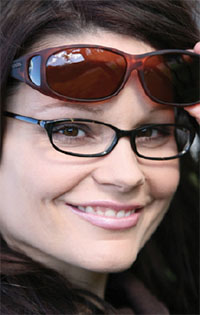 Live Eyewear, a leading manufacturer of fitover sunglasses and low vision aids, announces that it will establish offices in Vancouver to support the company’s initiative to service the Canadian eyewear market via a direct line of distribution. The expected date for the offices to open is the end of August.
Live Eyewear, a leading manufacturer of fitover sunglasses and low vision aids, announces that it will establish offices in Vancouver to support the company’s initiative to service the Canadian eyewear market via a direct line of distribution. The expected date for the offices to open is the end of August.
Previously, the company’s patented, optical grade fitover sunglass collections, including the world-renowned Cocoons and Vistana brands, were only available to Canadian eyecare professionals through the company’s authorized distributor, 20/20 Accessory Source.
“Our fitover sunglasses and low vision aids are firmly established in the Canadian market and are the preferred choice of eyecare professionals who demand optical-grade products for their patients. After many years of servicing the Canadian market through a distributor, we’ve decided that our loyal base of Canadian customers deserves the focus and attention of manufacturer direct support,” said Live Eyewear President Kieran Hardy. “We have an opportunity to not only deliver an improved level of day-to-day service, direct pricing, special incentives and broader product selection, but also to gain a more in-depth understanding of what our authorized dealers need in order to further grow the fitover category in Canada. The new line of direct communication will be extremely beneficial for both us and our customers.”
Inquiries regarding Live Eyewear’s patented collections of fitover sunwear and low vision UV absorptive filters can be answered by a Live Eyewear representative by calling the company’s toll-free customer service number at 1-800 834-2563.
Calvin Klein Capsule Collection
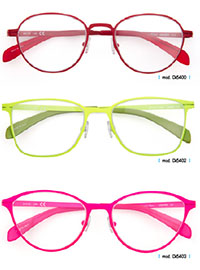 Released in June, the new Colorthin collection by Calvin Klein features a new, innovative technology and lightweight, flexible and vibrant styles. The five plastic models and four metal styles distributed by Marchon are available in vivid colours.
Released in June, the new Colorthin collection by Calvin Klein features a new, innovative technology and lightweight, flexible and vibrant styles. The five plastic models and four metal styles distributed by Marchon are available in vivid colours.
Colorthin frames are made in Italy and represent the cutting edge in eyewear technology – extreme lightness and material flexibility, combined with sophisticated materials that make them absolutely unique.
The innovative models feature excellent memory form, resistance to cracks and a featherweight feel, while maintaining correct positioning and flattering any face. Moreover, the Colorthin Calvin Klein frames distributed by Marchon are 100 per cent hypoallergenic.
The line is also durable and flexible under diverse conditions and easily adapts to temperatures that range from -13-150 degrees Fahrenheit. The temples can also resist twisting of up to 180 degrees.
The Colorthin Calvin Klein line’s functional shapes are defined by bright, deep colours with a soft, matte coated finish and the frames can be equipped with most of the lenses that are available on the market.
Catherine Deneuve and Marcolin Consolidate Partnership
 Marcolin Group and Catherine Deneuve have renewed their licensing agreement for the design, production and worldwide distribution of Catherine Deneuve Lunettes optical frames and sunglasses.
Marcolin Group and Catherine Deneuve have renewed their licensing agreement for the design, production and worldwide distribution of Catherine Deneuve Lunettes optical frames and sunglasses.
Initially launched through a licensing partnership with Viva International in 1989, this new multi-year agreement has been expanded to include the Marcolin Group.
“We are really pleased about the renewal of this license. Catherine Deneuve is the epitome of timeless elegance, something our company is proud to represent with these products,” said Giovanni Zoppas, CEO of Marcolin Group.
In December 2013, Marcolin finalized the acquisition of Viva International, significantly strengthening its brand portfolio and distribution structure, particularly in the U.S.

